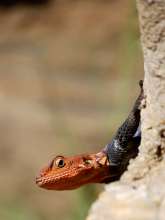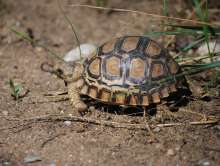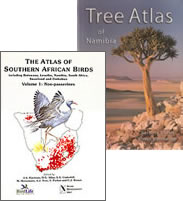Fauna
Birds
Bird diversity in the landscape is high and the species present include many of Namibia's endemic bird species such as Rüppell's parrot, Monteiro's hornbill, rockrunner and white-tailed shrike. Other species include blackfaced waxbill, short-toed rockthrush, whitebacked mousebird, Cape penduline tit, ashy tit, shaft-tailed whydah, and cinnamon breasted bunting. Over 300 bird species have been recorded within the landscape. One of the main features of the Daan Viljoen Game Park is the reservoir around which the bungalows and picnic sites are situated. As this is a permanent source of water, it attracts bountiful birdlife and other wildlife.
Mammals*
At least 75 species of mammals are expected to occur in the landscape. Of the mammals, 6 species (8%) are endemic to Namibia. Mammals include shrews (2 species), hedgehog, elephant shrews (3), bats (13), bushbaby, baboon and pangolin, hares/rabbits (3), molerat, squirrels (2), porcupine, springhare and dassie rat, rats and mice (17), carnivores (17), aardvark, rock dassie, warthog, antelopes (7).
Reptiles*
At least 78 species of reptiles are expected to occur, comprising at least 36 snakes (3 blind snakes, 1 thread snake, 2 pythons, 5 burrowing snake and 25 typical snakes), of which 8 are endemic to Namibia, 2 tortoises and 1 terrapin and 34 lizards, with 13 of these being endemic to Namibia.
Amphibians*
Roughly 13 species of amphibians are expected to occur. These include 3 species of toads, 2 rubber frogs, 2 puddle frogs and 1 each for bull frog, sand frog, kassina, rain frog, cacos and platanna. Three species are endemic.
Arthropods*
Arthropods are invertebrates with an exoskeleton, segmented body, and jointed limbs. They include the insects, arachnids, and crustaceans and are vital components in the cycling of nutrients through ecosystems. A diverse arthropod fauna occurs with many species which are especially adapted to the particular environmental conditions in the area. Many species are considered threatened by habitat degradtion, and the impacts of agriculture, alien species and pollution.
*Information based on specialist studies undertaken for the Windhoek Biodiversity Inventory - an inventory of an area overlapping the landscape.
Relevant literature
-
Aquatische Habitatnutzing von Flusspferden (Hippopotamus amphibius) in Dusternbrook
Aquatische Habitatnutzing von Flusspferden (Hippopotamus amphibius) in Düsternbrook. André Battermann, Dezember 2011/January 2012
Aquatic habitat of hippos in Dusternbrook» Download -
Bird species list for the landscape
Bird species list for the landscape, derived from data collected by the Southern African Bird Atlas Project (SABAP) phase 1. Harrison J.A., Allan D.G., Underhill L.G., Herremens M., Tree A.J., Parker V. & Brown C.J. (eds). 1997. The atlas of southern African birds. BirdLife South Africa, Johannesburg
» Download -
Birds of Düsternbrook Guest Farm
List of 180 birds observed at Düsternbrook Guest Farm, compiled in November 2006
» Download -
Common Birds of Düsternbrook Guest Farm
Illustrated list of Common Birds of Düsternbrook Guest Farm
» Download -
Game estimates for Dusternbrook and Ombota
Game estimates for Dusternbrook and Ombota February 2012
For 22 species, gives numbers utilised in 2011, estimated number on the farm and planned utilisation in 2012.» Download -
Mammal species list for the landscape
Checklist of mammals known or expected to occur in the Windhoek Green Belt landscape
» Download -
The birds of Daan Viljoen Game Reserve
Clinning, C.F. and Jensen, R.A.C. 1971. The birds of Daan Viljoen Game Reserve. Windhoek: Divison of Nature Conservation
Popular illustrated guide to the commoner birds of the reserve, with complete checklist at time of publishing -
The leopard population on Düsternbrook game farm
The leopard population on Düsternbrook game farm: A pilot study. Shaun Astbury, August 2011
The aim of this study was to provide an estimate of the distribution, abundance and population density of leopard on the farm from a combined track identification and remote camera trap survey, and GIS spatial analysis.» Download






